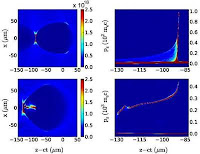Pump-probe experiments use one laser pulse, in this case an infrared pulse, to pump energy into a sample and then probe it with another laser pulse, in this case an LCLS X-ray pulse. Such experiments are ideal for looking at atomic and molecular interactions, which take place in tiny fractions of a second. The LCLS probe pulses were as short as a few quadrillionths of a second and a billion times brighter than any X-ray source produced in a laboratory.
 Coffee and his colleagues looked at the quantum behavior of electrons in nitrogen molecules, N2. The results represent a step toward a fundamental understanding of how nature converts light into chemical energy and might one day help revolutionize solar power, Coffee said.
Coffee and his colleagues looked at the quantum behavior of electrons in nitrogen molecules, N2. The results represent a step toward a fundamental understanding of how nature converts light into chemical energy and might one day help revolutionize solar power, Coffee said.Nitrogen atoms distribute their electrons between a lower and a higher energy shell. Using X-rays, the team picked off two electrons from the lower level, allowing a higher shell electron to descend and fill the vacancy. The energy released during this downward plunge ejected another electron from the atom, a phenomenon known as the Auger effect.
The team wanted to study how the nitrogen molecules' orientation affected this reaction. To do this, they used the infrared laser to line up the nitrogen molecules so that they were all facing the same direction.
"In a sense, we tried to make the gas act a little bit like a crystal," Coffee said.
After hitting the nitrogen with X-rays, the researchers detected electrons flying off and measured how the molecules' alignment with respect to the X-rays influenced the Auger effect. They observed numerous features that had strong dependence on the molecules’ direction. The results are currently being prepared for publication.
Future work will focus on how atomic bonds change as molecules either break apart or rearrange. Coffee thinks such work will lead to a deeper understanding of how nature converts light into energy. Ultimately, he hopes the results will lead to technology that will help humans generate power from the sun.
"I'm going for the solar power revolution, though I don't know where it will come from," he said. His gut feeling is that the important atoms to look at are carbon, nitrogen and oxygen.
"That's where energy in nature comes from," he said.
Coffee added that the team owes a debt of gratitude to the LCLS Controls, Accelerator, and Laser Groups, who made the experiment's success possible.
 When a high-energy proton beam travels through the human body it deposits most of its energy within a small volume, the size and location of which can be calculated to great precision. As a result, protons offer a distinct advantage over other forms of radiation used to destroy tumour cells because they cause less damage to surrounding healthy tissue. Unfortunately, the accelerators needed to generate the protons can cover thousands of square metres and cost some $100m. This has limited the number of proton-therapy facilities available and patients often have to travel considerable distances to be treated in this way.
When a high-energy proton beam travels through the human body it deposits most of its energy within a small volume, the size and location of which can be calculated to great precision. As a result, protons offer a distinct advantage over other forms of radiation used to destroy tumour cells because they cause less damage to surrounding healthy tissue. Unfortunately, the accelerators needed to generate the protons can cover thousands of square metres and cost some $100m. This has limited the number of proton-therapy facilities available and patients often have to travel considerable distances to be treated in this way. Now new theoretical work by scientists from the University of Texas and Commissariat à l'Énergie Atomique (CEA, France), to be reported at the 2009 APS Division of Plasma Physics Annual Meeting, has shed light on this mystery. Formation of the exceptional quality electron beam is attributed to the evolution of the bubble shape which, in turn, is directly associated with the nonlinear evolution of the driving laser pulse (nonlinear focusing and defocusing).
Now new theoretical work by scientists from the University of Texas and Commissariat à l'Énergie Atomique (CEA, France), to be reported at the 2009 APS Division of Plasma Physics Annual Meeting, has shed light on this mystery. Formation of the exceptional quality electron beam is attributed to the evolution of the bubble shape which, in turn, is directly associated with the nonlinear evolution of the driving laser pulse (nonlinear focusing and defocusing).